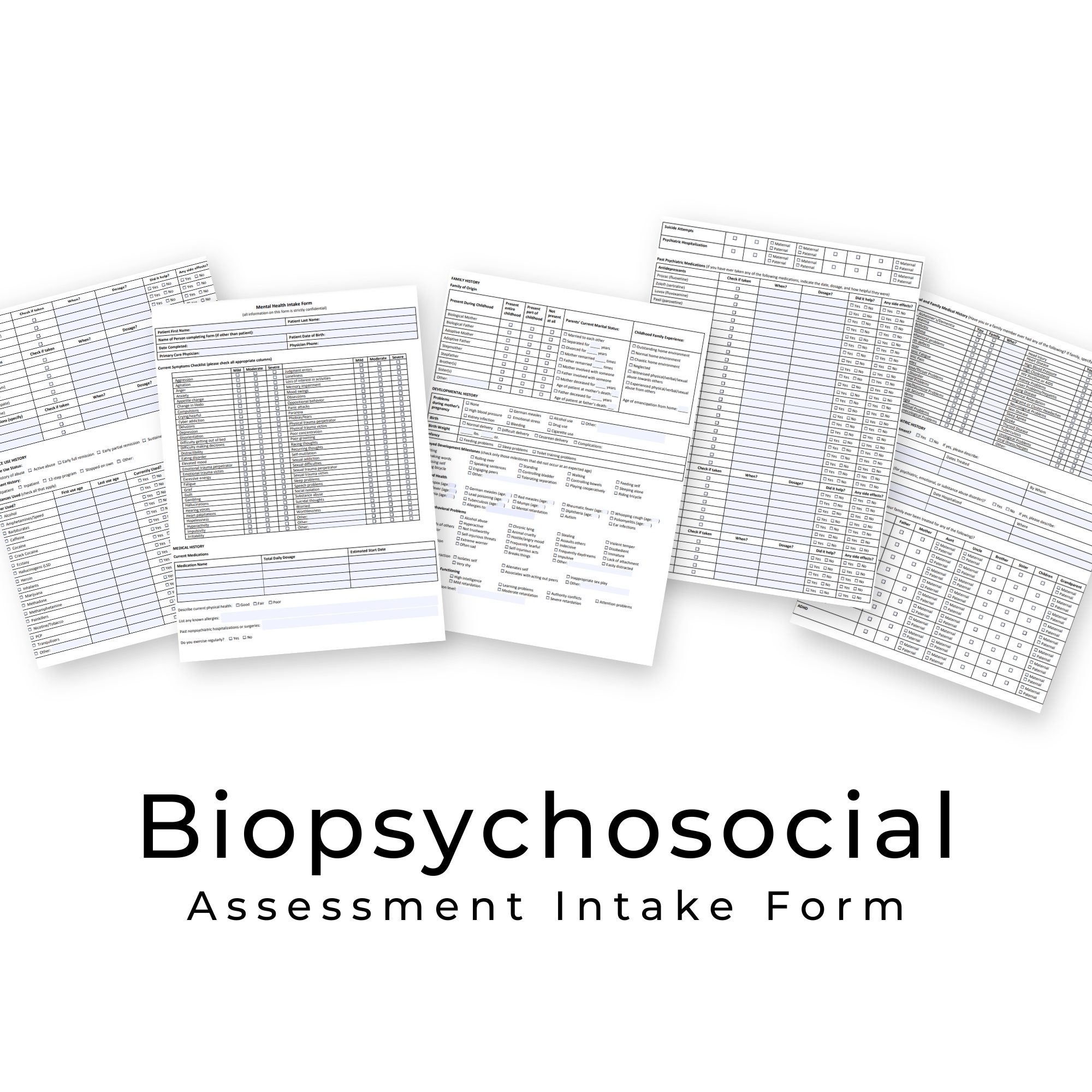

Biopsychosocial assessments help health professionals assess what biological, psychological and social factors could be impacting their client's health. This comprehensive assessment creates a foundation for understanding the factors contributing to your patient's well-being and enables clinicians to develop an effective treatment plan.
Mental health professionals typically conduct a biopsychosocial assessment as part of the initial assessment with clients. We've created this guide to help you learn how to use biopsychosocial assessment questions and write a report.
A biopsychosocial assessment helps counselors, social workers, and other behavioral health professionals learn about their clients on multiple levels and better understand their subjective viewpoints. As a result, biopsychosocial assessments enable therapists to diagnose and effectively treat their clients.
Mental health professionals typically conduct a biopsychosocial assessment as part of the initial assessment with clients. If you would like to use biopsychosocial assessments to learn more about your clients, we have information to help you get started. In this post, we'll explore the components of a biopsychosocial assessment, questions to ask clients, and how to write a report.
Biopsychosocial assessments are based on the biopsychosocial model proposed by Dr. George Engel. According to Engel's model, a person's body and mind are not separate entities. In other words, a person's biological, social and psychological states all intertwine and impact their well-being.
For example, if a patient experiences a physical illness while lacking social support, they may become depressed or anxious. Similarly, if a person has depression, they might withdraw from their friends and family and neglect self-care, impacting their physical and social wellness.
The biopsychosocial assessment is often necessary when psychological factors alone do not explain the presence of a mental health condition. Psychological factors do not consider the many social and biological factors that can impact one's mental state.
Mental health professionals recognize the need to view clients holistically and consider how various aspects of a person's life might contribute to a mental health issue, impair functioning or maintain a disorder.

Download our biopsychosocial intake form to streamline the collection of client data
As you can tell by its name, the biopsychosocial model includes three components: biological, psychological and social factors. You'll want to focus on these aspects as you gather data for your assessment via patient questionnaires and face-to-face interviews. To show you what to cover, here are descriptions of each component:

Biological factors refer to aspects of an individual's physical makeup, such as genes, physiology, hormones, neurotransmitters, chemistry, brain structures and organ system functioning. Many mental conditions are caused by a combination of biological, psychological, genetic and environmental factors.
Since genes can play a part in a person's mental health and increase the risk of developing certain disorders, counselors should consider a client's family history during their initial meeting.
You might take the following information about your client into account:
Biological questions help you understand a client's medical issues and history, which can impact other areas of their life. Consider asking your client to fill out a questionnaire about their personal medical and mental health history, their family's medical and mental health history, their substance use history, and their current sleep, diet and exercise habits.
You might ask questions such as:

Psychological factors refer to a person's thought processes and how they influence mental states and behavior. Psychological factors can impact a person's physical well-being and vice versa.
For example, one study found that at least 36% of patients with chronic pain experienced depressive symptoms. Chronic pain and depression are correlated — as the pain worsens, so does the risk, duration and severity of depression. According to the American Psychological Association, more than 55% of adults who live with chronic pain also have symptoms of anxiety and depression.
To understand your clients better, consider psychological factors and related information, such as:
The psychological component of the biopsychosocial assessment offers a more accurate look at a patient's thoughts, behaviors and feelings. To identify psychological factors that may be influencing your client's health, you can give them a questionnaire containing a current symptom checklist and a checklist of emotional and behavioral issues.
You might also ask the following questions:
Social factors include relationships, culture, money, family, work and housing. Research shows that social determinants, such as education and socioeconomic status, can significantly impact mental health. For example, higher income levels often correlate with positive mental health due to access to effective health care, sufficient food security and safe housing. Alternatively, income volatility, debt and perceived job security can have a substantial impact on mental health.
To learn about a client's social circumstances and how these factors influence their mental and physical health, you might focus on the following:
Ask questions that help you understand your client's past and current relationships, work-related stressors, finances and involvement in their community. You might ask:

After you've gathered data about your client, you can write a biopsychosocial assessment report. Your report will help you understand your client as a whole individual to devise an effective treatment plan. You can also share your assessment with colleagues or physicians to coordinate care.
Here's a biopsychosocial assessment outline to help you get started:
Begin your report with basic information about your client. This should include:
Examine the client's history and current functioning and include relevant details. Address the following areas when writing your report:
After you provide an overview of your client's current and past psychological, biological and social states, it's time to include your professional assessment. You might offer the following information:
Instant Webinar
Write Better Biopsychosocial Assessments
In this webinar, we review the history of present illness, past psychiatric history, medical history, social history, and family history. We review how to properly document the level of care justification for payor sources. Finally, we cover how using an electronic medical record system to document mental health treatment can improve efficiency, allowing practitioners to devote their time and attention to individuals who need their assistance.
As you write your biopsychosocial assessment report, it's important to consider who will use your assessment to provide care. Here are tips to help communicate your assessment with colleagues and other care providers:
Make sure to frame information in a way that separates facts from your impressions. Objective facts include things the client actually said, whereas subjective impressions include how the client appeared to you. Be sure to clarify who said, thought or did something in your report.
For example, to have an objective fact, you might write, "The client said he felt sad when he lost his mother." To state a subjective impression, you might write, "The client seemed sad when he talked about his mother." You'll want to be as objective and unbiased as possible.
Be sure to include a balance of information to ensure your evaluation is accurate and effective. Note the client's strengths, challenges, facts and impressions.
Decide which problems are most important and need urgent attention. Spend more time writing about these issues in your report. You'll also want to present the primary issues first.
Other physicians or therapists may read your report, so it's crucial to be as accurate as possible. Ensure you accurately convey what the client or other sources said or did, and remove or rewrite errors or misleading information.

You do not need to include everything the client said, thought, felt or did in your report. Instead, aim to include only relevant information.
It's also possible that your biopsychosocial assessment may not yield relevant information in all three factors. For instance, you may find that a patient's depression is associated with their living situation — a social factor — but cannot identify a biological factor that may contribute to their depression.
All documentation should be organized in a logical manner that's easy to comprehend. For example, if your evaluation includes a diagnosis of major depressive disorder, your report should include detailed mentions of the client's loss of interest in pleasurable activities, sleep disturbances or appetite changes.
While you do not have to ask every question outlined in a biopsychosocial assessment, you can ask relevant follow-up questions.
For example, if a client responds to the question "How much work-related stress is in your life?" with "I am extremely overwhelmed with work-related stress," you can ask follow-up questions about the intensity, frequency and onset of their experiences.
You can use the following assessment tools and templates to make your evaluation more efficient and support your official diagnosis: